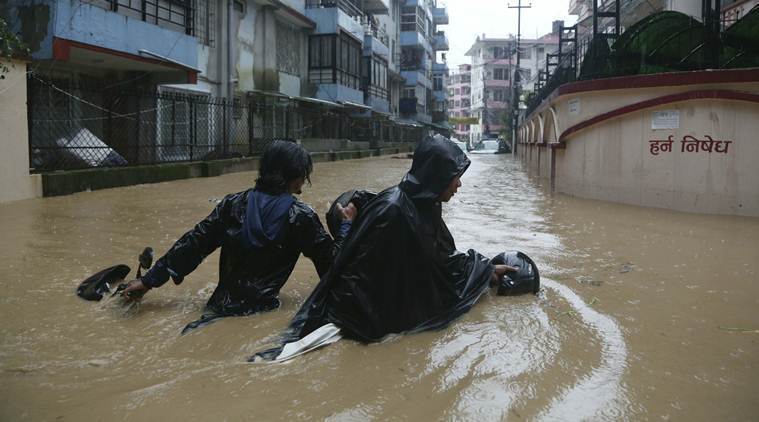The hardest-hit country appeared to be Nepal, where police said Monday that 67 people had died as a result of the monsoonal rains that began last Thursday night and set off widespread flooding.
Written by Bhadra Sharma and Mike Ives
The death toll mounted Monday from flooding and landslides caused by torrential weekend rains in India and Nepal, as rescuers carried out desperate searches for survivors and officials in nearby Bangladesh braced for the floodwaters to move downstream.
The hardest-hit country appeared to be Nepal, where police said Monday that 67 people had died as a result of the monsoonal rains that began last Thursday night and set off widespread flooding, particularly in the country’s southern plains along the Indian border.
Officials said that at least 68 others had been injured in landslides and flooding and that an additional 30 people were still missing. Photos published by Nepal’s news media showed flood victims wading through murky, thigh-high waters, and teams of rescuers plying streets in inflatable boats.
Nine major highways in Nepal had been blocked by floods and mudslides, 3,366 people had been rescued and 16,520 households had been temporarily displaced as of Monday, the National Emergency Operation Center said. No estimates on property or infrastructure damage were available.
“We are trying to provide dry foods — rice, noodles and biscuits — to flood victims, but it’s not easy to access affected people as whole villages are inundated and roads connecting to those villages are damaged,” Ajay Gupta, the mayor of Gaur, a town along Nepal’s southern border with India, said by telephone Monday afternoon.
Beda Nidhi Khanal, the head of the National Emergency Operation Center, said Monday that bad weather had grounded four helicopters based in Kathmandu, the capital of Nepal, where crews had planned to carry out rescue operations and supply food to disaster-hit areas. He said only two helicopters, both based near the Indian border, were operating in the disaster zone as a result.
Gupta said his town had not yet received any relief materials from the federal government as of Monday afternoon, and that many electricity and telephone lines in the area were still down. Soldiers and police officers had rescued several people using rubber boats, he added, but two people from the town had drowned.
In India, at least 25 people have died so far from the rains and floods, Mohamad Farukh, the chief executive of Rapid Response, a nongovernmental charity focusing on disaster relief, said in a text message Sunday. Indian officials said a day earlier that about 750 people from the worst-affected states, Assam and Bihar, had been rescued over the preceding three or four days.
In the northern Indian town of Solan, which lies in a hilly border region hit by heavy rains, seven soldiers and one civilian died after a three-story building suddenly collapsed, officials told The Associated Press on Monday. They said 31 people had been rescued, and that the soldiers had been having a party in the building’s ground-floor restaurant when the collapse occurred.
In Bangladesh, 14 deaths have been recorded as a result of flooding in low-lying areas of the country since July 9, and 60,000 families in those areas were still “marooned in their home or community shelters” as of Sunday, the Bangladesh Red Crescent Society said in a report.
The rains have also flooded parts of the world’s largest refugee camp, in southeastern Bangladesh, which is home to more than half a million Rohingya Muslim refugees who fled violence in neighboring Myanmar, according to the United Nations.
Raqibul Alam, a program manager at the International Federation of Red Cross and Red Crescent Societies in Bangladesh, said Monday afternoon that while torrential rains had temporarily stopped in that part of the country, he was still concerned.
“At this point, the main challenge is the water coming down from upstream” rivers in Nepal and India, coupled with the threat of further rainfall that is expected in the area over the next two days, Alam said.
Every year, from June to September, monsoon season brings heavy rains that pummel South Asia, regularly provoking deadly flooding. In 2017, more than 1,000 people died in floods across the region, including in Nepal, where thousands of homes were destroyed, dozens of people were swept away, and elephants were pressed into service to rescue people from swirling waters.
The flooding this year has been particularly heavy.
In India, for example, 32 people died in early July after the heaviest monsoon rains in a decade struck Mumbai and nearby areas.
And in southern Bangladesh, a group of aid agencies said Friday that more than 45,000 people in refugee camps had been affected since the end of April by “weather-related incidents,” compared with 55,000 during the entire monsoon season last year.
Heavy flooding has also affected China, where an official at the Ministry of Water Resources said Sunday that flooding had been reported in a record 377 rivers this year, according to Xinhua, the state-run news agency.
In Nepal on Monday, there was speculation in the news media about whether some of the flood risks had been exacerbated by factors like climate change, road and infrastructure construction by India across the border, and the mining of natural resources like sand and timber from the nearby Chure mountain range.
Gupta, the mayor of Gaur, said his more immediate concern was preventing a local hydropower dam from overflowing the banks of its reservoir.
Preparations are underway to release water from the reservoir to avert a crisis, he said. “But we are terrified that the water could overflow our settlement again when it is added into local rivers.”
Source: Read Full Article


